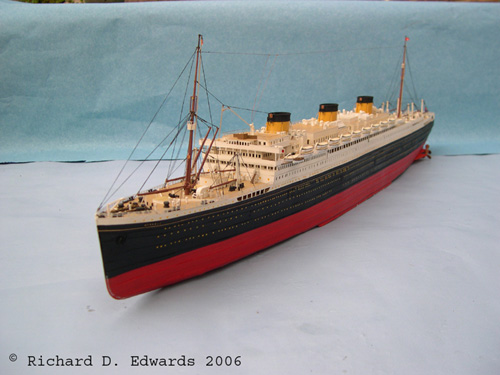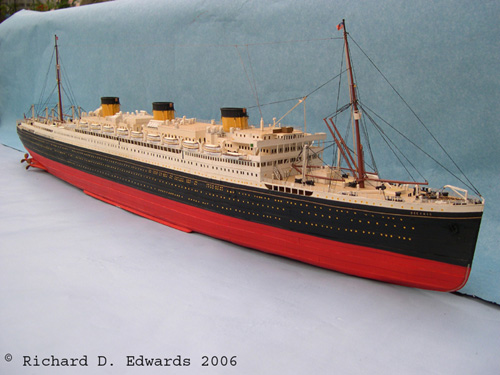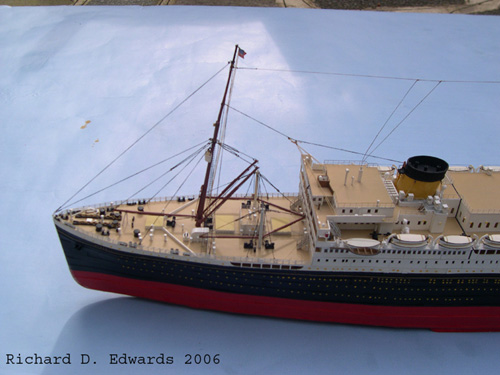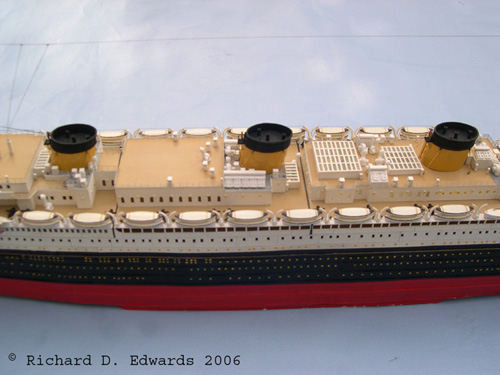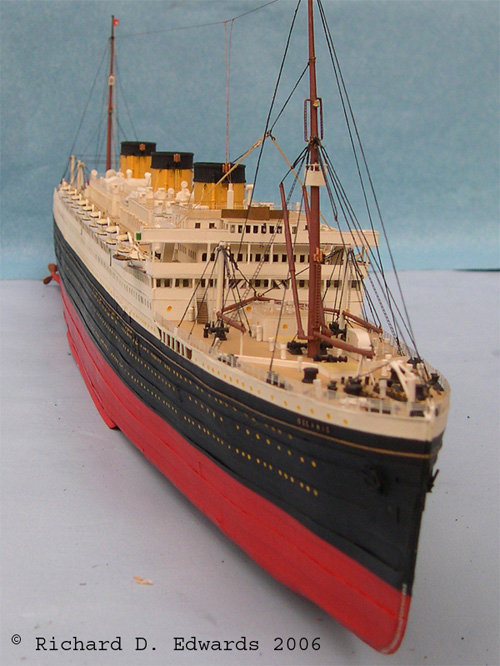
"White
Star line's proposed MV Oceanic III of 1928"
By Richard Edwards
This is my 1/350 scale model of the White Star line's proposed MV Oceanic III of 1928.
I bought copies of the general arrangement plans from Harland and Wolff and built the model from these. Unfortunately the plans were not as detailed as they could have been as H&W only retained the basic plans ten years after the project was cancelled. The surviving GA plans only show the layout of each deck and none of the finer details that can be seen on more complete general arrangements. As such, they do not show the height of the funnels or masts, positions of the numerous ventilators and fans, windows or portholes, or even the number of lifeboats, however they do show the lifeboat stations.
The plans tell us that Oceanic was far from the 1010 feet long monster liner we have always been led to believe she was going to be. Oceanic was 935 feet long, 100 feet wide and 105 feet high, making her the same dimensions as Bremen and Europa. She would probably have been about 52,000 tons but this is only an estimate.
Many of us have seen the following artists representation of Oceanic in books such as Roy Anderson's "White Star" and Williams & de Kerbrech's "Damned by Destiny," and without any other information have taken it for granted that this is how Oceanic would have appeared. Unfortunately this is not the case. This diagram is simply the original proposal White Star submitted to Harland and Wolff when designing began. That is why this Oceanic has more than a passing resemblance to Majestic and not a Harland and Wolff ship of the early twentieth century.
Oceanic was the updated and slightly enlarged fourth Olympic class liner and not White Star's Queen Mary, however she did incorporate many of the features from Majestic such as the upper deck houses, the double height Dining Room on D deck, and the gymnasium and large swimming pool down on F deck
Luckily the general arrangement lists the passenger summary. Oceanic was to carry 2808 passengers made up of 722 in first class plus 240 interchangeable with second class, 464 in second class plus 286 interchangeable with third class, and 1096 in third class. The dining saloons catered for 570 in first, 450 in second and 600 in the two third class saloons. Crew numbers were not recorded.
From the completed model it is clear that her hull was very slender and obviously she was designed, if not actually built, for speed. H&W always stated that Oceanic was to be a 30 knot ship and she may well have proved faster than CGT's Normandie. Oceanic had three remarkable engine rooms. The furthest forward was 130 feet long and contained the oil fuel tanks and burners, and the two 120 feet long engine rooms directly aft of the first contained two sets of 100 feet long and 35 feet high diesel motors, one for each propeller.
The Oceanic GA is date stamped 9th March, 1926 and her Modernist design is clear to see. When you compare Oceanic's forward façade to this photograph of le Corbusier's Villa Stein of 1927, the similarity is unmistakeable. It is in stark contrast to the Edwardian grandeur of Olympic and Titanic the luxuriant Art Deco of Queen Mary and Normandie.
So what effect would Oceanic have had, had she been completed and entered service for White Star? We cannot say for certain but had she taken the Blue Riband on her maiden voyage, probably some time in 1932, she would have captured all of what little passenger traffic was crossing the Atlantic at that time. White Star's share price would have risen rapidly and this almost certainly would have spelt doom for Cunard whose Hull 534 was abandoned half complete on the Clyde. The Cunard/White Star merger would still have gone ahead but probably with White Star in overall command.
***
Although I have made models of Titanic, Oceanic was the first model I scratch built and I deliberately strived to make her as accurate as possible, using no artistic license whatsoever. I built the model from styrene sheet throughout. The hull was made as a box girder with about 30 ribs and spacers giving the hulls shape, which were glued to a central spine. The hull was then clad with Microstrip shell plates. Fine details such as the lifeboats and masts were bought from Toyway.
For the final details I bought the rigging plan
and general arrangement of White Star's Britannic III which although half the
size, was very similar in many ways to Oceanic. It was after studying these
plans that I was able to make educated guesses regarding the positions of the
ventilators and the type of rigging that would have been used. Similarly I calculated
Oceanic's funnel size by working out the size difference between Oceanic and
Britannic (1.313) and then increased Britannic's funnel size by that number.
Strangely enough when viewed from a distance, Oceanic's apparently small funnels
appear much larger and much more in proportion with the rest of the ship than
one might expect.

